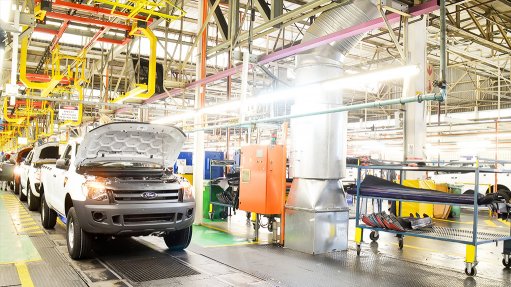
FORD RANGER New high-capacity air compressors were installed at a Ford assembly plant where the Ranger is manufactured
Vehicle manufacturer Ford Motor Com-pany of Southern Africa (FMCSA) has introduced a range of energy- efficient technologies at its Silverton assembly plant, in Pretoria, reducing its energy consump-tion and demand on the national grid, while also bringing about commensurate cost savings.
“Ford wants to ensure that our manufacturing and assembly operations are as energy efficient as possible, have a lower impact on the environment, produce vehicles to the highest quality standards and provide a safe working environment for all,” says FMCSA operations VP Ockert Berry.
He adds that, with the electricity supply constraints currently being experienced in South Africa, it is essential for FMCSA to enhance its business to reduce its demand on the network, noting that this also enables the company to ultimately reduce costs and improve profitability.
The Silverton assembly plant, which produces the Ford Ranger for South Africa and 148 export markets, recently installed two new high-capacity air compressors. These replaced five older air compressors that the plant relied on for the assembly line, body shop, trim line and repair centre. The new compressors provide the latest technology and significantly higher levels of efficiency owing to their variable speed drive (VSD) systems.
“The new VSD system allows the compressor to adjust its output to changing demands, where the older units provided a constant supply of compressed air,” says FMCSA Silverton assembly plant energy coordinator Vincent Hlatywayo.
“As a result, the new compressors are much more energy efficient and, by using the latest technology, the two new VSD units provide an equal capacity to all five previous compressors combined. “We have reduced the total daily demand of the compressors by 150 kW, or 41%, since the changeover in January this year,” he states.
A similar approach was also adopted for the paint shop, which replaced three older compressors with higher efficiency units, and recorded a 38% energy saving, compared with previous energy demand.
As part of its broader energy monitoring programme, a sophisticated energy measuring system was installed throughout the Silverton assembly plant to provide accurate measurement of energy use and trends. The system features more than 60 m located throughout the facility that measure a variety of aspects, such as electricity, water, gas, steam and compressed air use, as well as the quality of the electricity supply.
“The measuring system allows us to draw baselines and targets for each department, so they are able to actively monitor, control and manage their energy use,” says Hlatywayo.
A demand side management (DSM) project, conducted in conjunction with Eskom, has seen all of the plant’s lighting requirements assessed and improved. The 2 000 high-bay lights used on the production line now boast more efficient 250 W bulbs in place of the older 400 W versions, yet deliver the same lux levels.
Further, the 13 000 fluorescent lights employed at the plant have been fitted with 36 W electronic control gear, which replaces the 70 W mechanical control gear used previously.
The team also installed polycarbonate roof sheeting in the assembly plant, which allows more daylight to filter onto the production line and reduces the need for artificial lighting.
Another energy-saving project was the retrofitting of heat pumps in place of the standard geysers used in the ablution facilities, both within the plant and the adjacent warehouse. Since the heat pumps were commissioned in 2014, energy consumption has been halved, with peak demand reduced by about 130 kW. Average monthly electricity consumption for these facilities has dropped by 24 540 kWh.